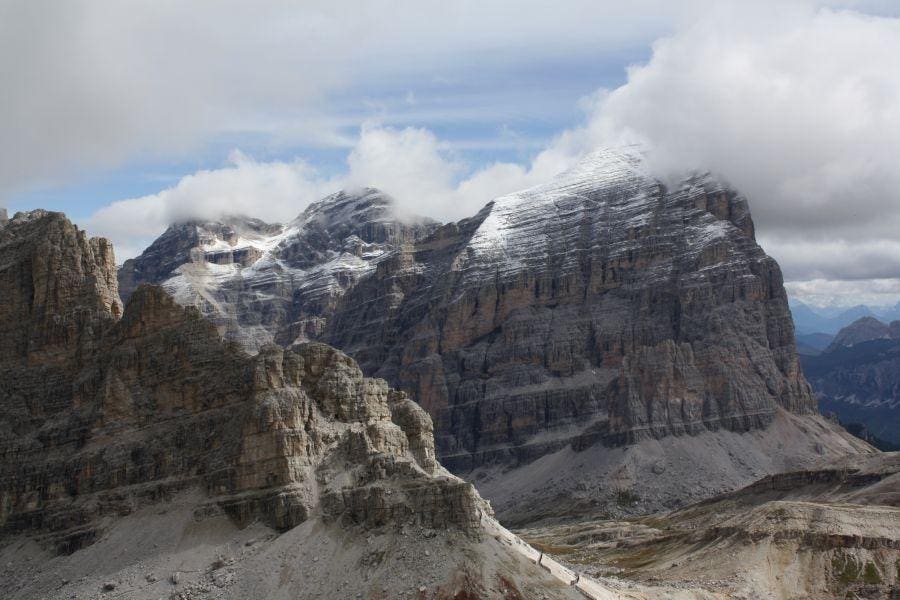For 200 years, scientists have failed to grow a common mineral in the laboratory under the conditions believed to have formed it naturally. Now, a team of researchers from the University of Michigan and Hokkaido University in Sapporo, Japan have finally succeeded, thanks to a new approach developed from atomic simulations.
Their success resolves a long-standing geological mystery and can help to create new crystalline materials.
Dolomite was first described as a mineral in 1792 by Swiss naturalist Nicolas de Saussure after analyzing some rock samples collected by French adventurer Deodat Sylvain Guy de Tancrède Greatet de Dolomieu in the mountains of Italy and Austria.
Dolomite—a calcium-magnesium-carbonate—forms the Dolomite mountains in Italy, the Niagara Falls escarpment between the U.S. and Canada, the White Cliffs of Dover in the U.K. and is very abundant in marine sediments older than 100 million years. But curiously enough nowadays it forms only sporadically in tidal zones when salt water evaporates and it is almost impossible to create under laboratory conditions. This apparent paradox—with a rare mineral forming kilometer-thick deposits and shaping entire landscapes—was dubbed “the Dolomite Problem” by geologists.
The secret to finally growing dolomite was solved using an advanced software that can simulate how atoms form a stable crystal network. Unlike previous simulations, this new approach also considered changes in the atomic structure over time.
“Our software calculates the energy for some atomic arrangements, then extrapolates to predict the energies for other arrangements based on the symmetry of the crystal structure,” said Brian Puchala, one of the software’s lead developers and an associate research scientist in U-M’s Department of Materials Science and Engineering.
When minerals form in water, atoms usually deposit neatly onto an edge of the growing crystal surface. However, the growth edge of dolomite consists of alternating rows of calcium and magnesium.
In water, calcium and magnesium will randomly attach to the growing dolomite crystal, often lodging into the wrong spot and creating defects that prevent additional layers of dolomite from forming. This disorder slows dolomite growth to a crawl, meaning it would take 10 million years to make just one layer of ordered dolomite.
Luckily, these defects aren’t locked in place. Because the disordered atoms are less stable than atoms in the correct position, they are the first to dissolve when the mineral is washed with water. Repeatedly rinsing away these defects—for example, with rain or tidal cycles—allows a dolomite layer to form in only a matter of years.
This video shows how cycles of deposition and dissolution can create an energetic stable dolomite-crystal in a (geologically speaking) short time.
The test this hypothesis, the researchers needed to create dolomite in their lab.
After placing a tiny dolomite crystal, acting as seed for further crystal growth, in a solution of calcium and magnesium, the researchers recreated the needed cyclical conditions using an electron beam that zapped the crystal over 4,000 times over two hours. The beam splits the solution, which creates acid that removes a few atoms from the unstable spots. The vacancies in the crystal structure are quickly filled by magnesium and calcium atoms precipitating from the solution, creating the stable rows of atoms needed to form dolomite.
The dolomite crystal was seen to grow approximately 100 nanometers—around 250,000 times smaller than the diameter of a coin. Although this was only 300 layers of dolomite, never had more than five layers of dolomite been grown in the lab before.
This possible solution for the Dolomite Problem provides also a new approach for engineering and creating crystalline materials, widely used in modern technologies like semiconductors, solar panels, batteries and other tech.
“In the past, crystal growers who wanted to make materials without defects would try to grow them really slowly, our theory shows that you can grow defect-free materials quickly, if you periodically dissolve the defects away during growth.” concludes Wenhao Sun, Dow Early Career Professor of Materials Science and Engineering at U-M and the corresponding author of the study.
The study “Dissolution enables dolomite crystal growth near ambient conditions” was published in the journal Science (2023). Additional material and interviews provided by University of Michigan.
Read the full article here






